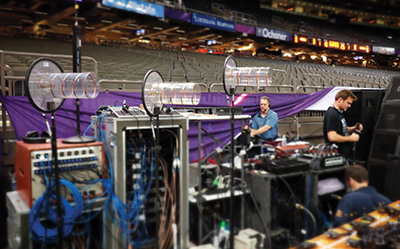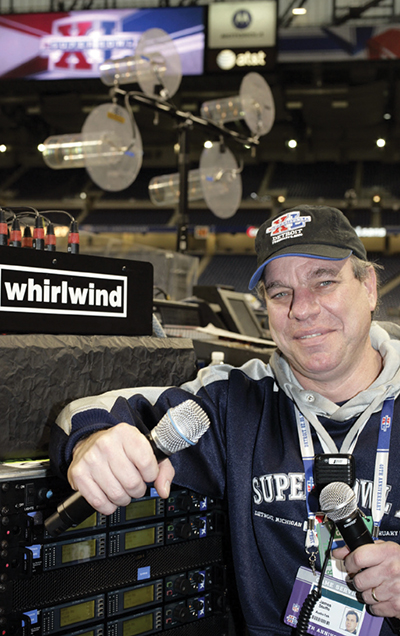Wireless Mic Users Cope With Fewer Options

(L to R): Freelancer Skip Kent, along with Brooks Schroeder and John Garrido from Professional Wireless Systems, set up PWS’ domed helical antennas at a recent sporting event.
LOS ANGELES—The FCC’s Auction 73 in 2008 drastically changed the landscape for professional audio operators working with wireless equipment, ultimately taking away one-third of the available spectrum. In the new wireless landscape of database administrators and Super Wi-Fi, with consumer television band devices expected in less than a year, wireless audio coordinators surely have their work cut out for them.
Depending upon the city, the reduced frequency spectrum environment can be a challenge, said Jason Eskew, project manager for Orlando, Fla.-based Professional Wireless Systems, a wholly owned subsidiary of Masque Sound. “But with decent planning and good tools we haven’t had to tell anybody no yet.”
Frequency coordination has become critical for major sports, entertainment, and political events. Eskew noted that the NFL has now brought its Game Day Coordinators in-house. “They do a fabulous job—and if you could quote me on that, that would be helpful!”
The GDC wrangled something like 7,000 RF channels citywide at this year’s Super Bowl, he said. “The NFL has their own custom software that they wrote inhouse. It borrows features and ideas from other folks, including us.”
Other organizations are also looking to implement similar practices, he reported. “Yet another NCAA conference is considering formalizing frequency coordination practices; they are forming a group to discuss and make recommendations for policy.”
COLLEGE CONUNDRUM
But college sports, and football in particular, highlight the increasing strain being put on the available spectrum. Many of the teams use 2.4 GHz intercom systems, yet that unlicensed W-Fi spectrum is particularly precious to cellphone providers. “Their goal is to give fans a first class experience where they can get stats, watch video, and receive additional content on their personal devices,” said Eskew.
Get the TV Tech Newsletter
The professional video industry's #1 source for news, trends and product and tech information. Sign up below.

James Stoffo, chief technology officer of Radio Active Designs Accordingly, the carriers want to get people off their networks and onto Wi-Fi, “because their networks can only support so much data,” commented Eskew, who reported that he had even heard of teams being given 900 MHz comms systems by the telcos: “They’ve ponied up and bought replacement equipment for the teams.”
Accordingly, the carriers want to get people off their networks and onto Wi-Fi, “because their networks can only support so much data,” commented Eskew, who reported that he had even heard of teams being given 900 MHz comms systems by the telcos: “They’ve ponied up and bought replacement equipment for the teams.”
The problem is, noted James Stoffo, chief technology officer of Radio Active Designs and one of the most experienced frequency coordinators working today, is that the TVBDs set for release early next year are unlikely to play nicely with pro audio equipment, even with the protections set up by the FCC.
Take the Rose Bowl, for example, he said, where 100,000 people could all be carrying these devices. “They’re going to generate all kinds of intermods in and amongst themselves, and rebroadcast that.”
Cellphones already interfere with equipment: “We know that Sprint splatters on top of Riedel’s 1.9-gig equipment, for example,” said Stoffo. “I’ve had to shut down repeaters at 869 to 896 because they were stepping on a 905-meg time clock at an NBA game.”
The FCC has set aside two 6-MHz TV channels in each city, either side of Channel 37—which is reserved for radioastronomy/medical telemetry purposes—that can be used by licensed pro audio equipment. Yet Stoffo is concerned that the “Super Wi-Fi” consumer devices, which may operate in the UHF band above 512 MHz, the upper 800 MHz band, and at 1.9 GHz, could still interfere. “My fear is that these devices will splatter even inside of the six-meg band that the FCC has left us with that we’re supposed to be protected in.”
VHF ALTERNATIVE
To help alleviate the situation, Stoffo has partnered with two other frequency coordinators, one working on Broadway, the other a broadcast specialist, to create Radio Active Designs. The new company, which will launch at the NAB Show (sharing space with Quantum 5X in Booth C2839), is introducing an intercom system that operates in the VHF bands and uses a form of AM called ENB, freeing up UHF bandwidth for microphones and in-ear systems.
“On the events that my partners and I have worked as frequency coordinators, we’ve found that if you add up the in-ear monitors, the microphones, and the IFBs, that’s still less than the number of intercom frequencies,” Stoffo said. “If we can remove all of those comms frequencies out of the UHF band that gives you some wiggle room for your microphones and in-ears,” he explained.
“When I got into this business everything was VHF,” said Stoffo, who gained his RF expertise working on submarines in the U.S. Navy. Now, he said, less than two percent of the equipment he sees is VHF.
Current UHF equipment is FM; Radio Active Designs’ system instead uses AM. “An FM system takes up a minimum of 300 kHz, whereas you can get just as good audio quality out of 25 kHz in an AM system,” Stoffo said. “So I can pack at least 10 to 15 times the number of frequencies into the same space just by changing my modulation scheme.
Stoffo says they’ve calculated that they can fit 30 base stations of intercom with 180 packs in the same space of UHF spectrum that one current 4-drop FM technology system would take up. “And we also free up space for the microphones, which aren’t as spectrally efficient,” he said.
“We’re calling it ‘Enhanced Narrow Band’ technology, a form of AM with DSP. We’ve repackaged it into a system that ends up appearing to be revolutionary, but really it’s technology from the ‘60s.”
Current FCC rules could work in his company’s favor. “The FCC regulations state that before you go to a database administrator to seek protection from these consumer digital devices you have to look in all other legal bands, including VHF,” said Stoffo. “Once someone comes out with a piece of equipment that operates in VHF and it works, you’re almost obligated by the FCC to use that equipment before you can seek protection from anything more than the two sixmeg chunks that they’ve given us up in UHF.”
Steve Harvey began writing for Pro Sound News and Surround Professional in 2000 and is currently senior content producer for Mix and a contributor to TV Tech. He has worked in the pro audio industry—as a touring musician, in live production, installed sound, and equipment sales and marketing—since November 1980.
